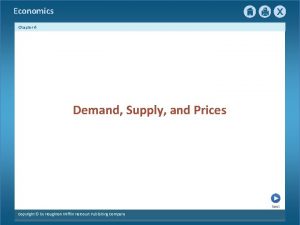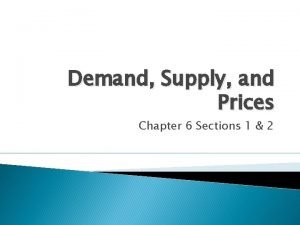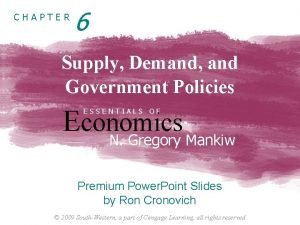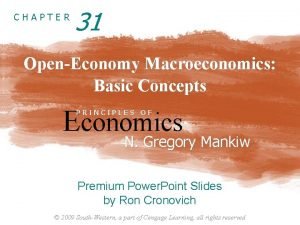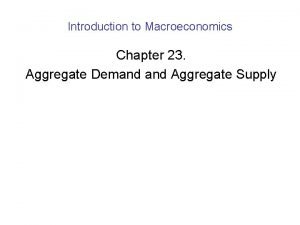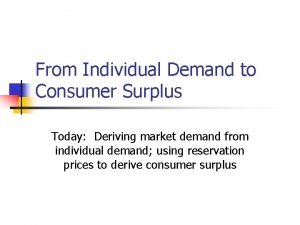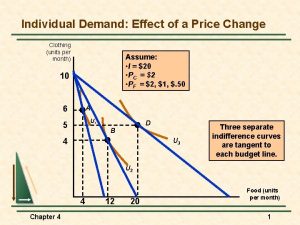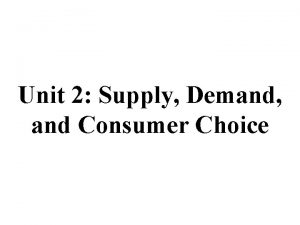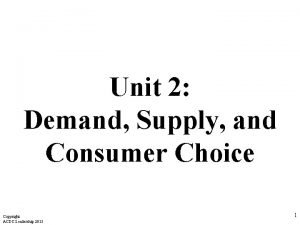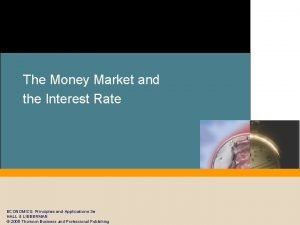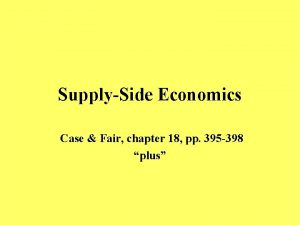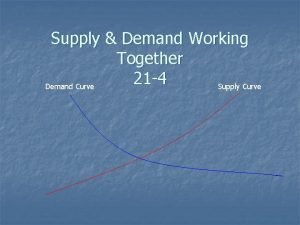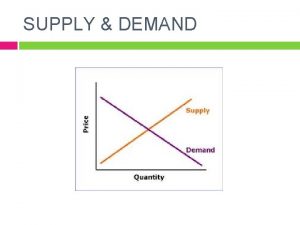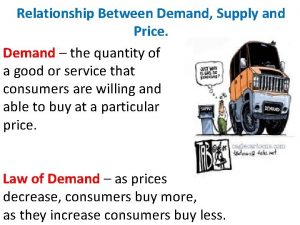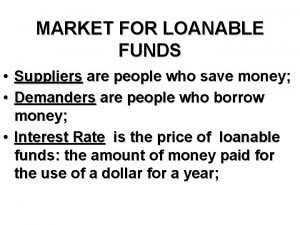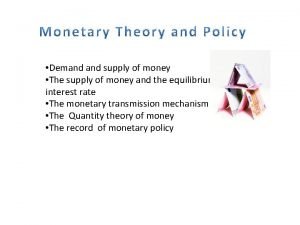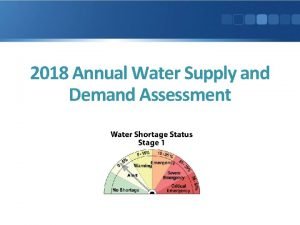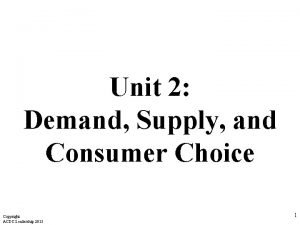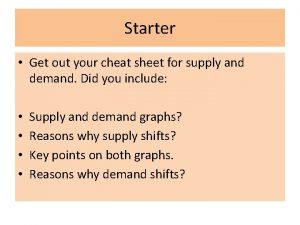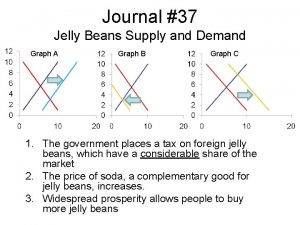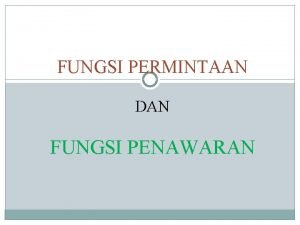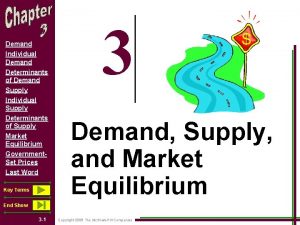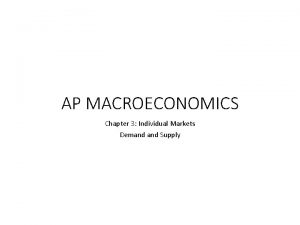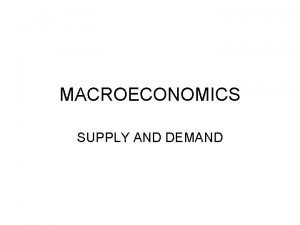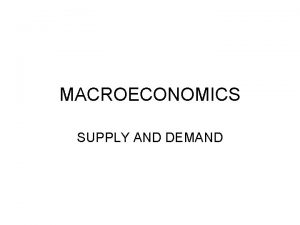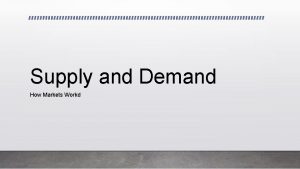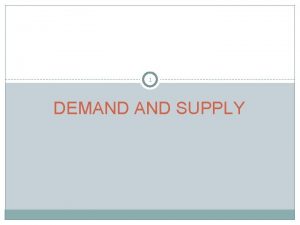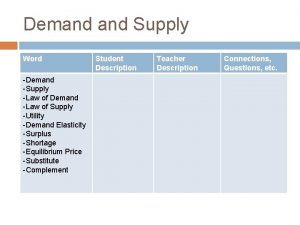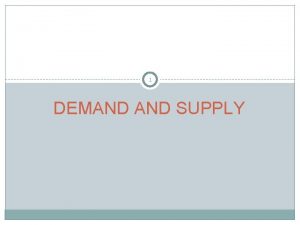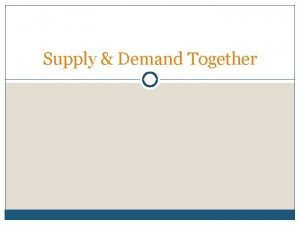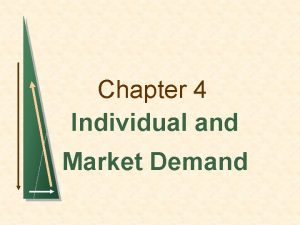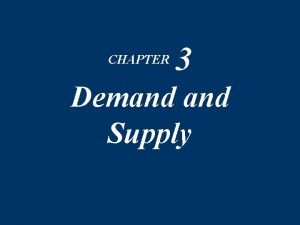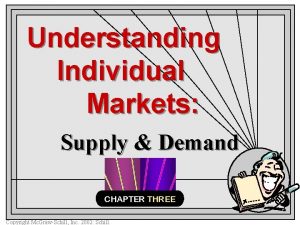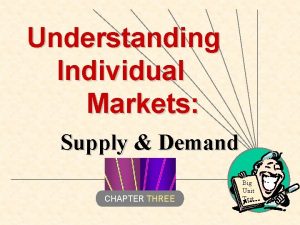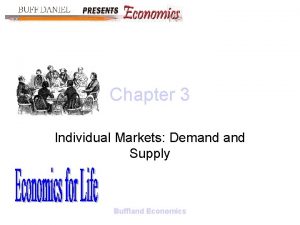AP Macroeconomics Chapter 3 Individual Markets Demand Supply

















































- Slides: 49

AP Macroeconomics Chapter 3 Individual Markets: Demand Supply

Demand How Much Buyers Want

A Market �Interaction between buyers and sellers • Buyers demand goods • Sellers supply good

Demand An Individual Buyer’s Demand for Corn Price per Bushel � Quantity Demanded per Week $5 10 $4 20 $3 35 $2 55 $1 80 Shows the quantities of product that will be purchased at various prices

Law of Demand �Ceteris Paribus, as price falls, the quantity demanded rises, and as price rises, the quantity demanded falls

Exceptions to the Law of Demand �Price can deter people from making purchases • (Reason behind Sales)

Exceptions to the Law of Demand �Diminishing marginal utility • Each buyer will derive less satisfaction from each successive unit purchased

Exceptions to the Law of Demand �The Income Effect • Enables a buyer to purchase more then they would normally buy

Exceptions to the Law of Demand OR… �The Substitution Effect • If a product exceeds the buyers purchasing power, they will a less expensive alternative

The Demand Curve � Relationship between price and quantity • Price must always appear on the Y axis with S&D

Individual Demand P 6 P Qd $5 10 4 20 3 35 2 55 1 80 5 Price (per bushel) Individual Demand 4 3 2 1 0 D 10 20 30 40 50 60 70 80 Q Quantity Demanded (bushels per week) 3 -11

Individual Demand Can Increase or Decrease P 6 P Qd $5 10 4 20 3 35 2 55 1 80 5 Price (per bushel) Individual Demand Change in Quantity Demanded 4 3 2 1 0 D 2 Decrease in Demand 2 4 6 8 10 D 1 D 3 12 14 16 18 Q Quantity Demanded (bushels per week) 3 -12

Market Demand Focused on many buyers instead of individuals � Market Demand = Price most can afford (x) number of buyers � Price per Bushel Quantity Demanded per week, single buyer Number of Buyers Total Quantity in the Market Demanded per week $5 10 X 200 $4 20 X 200 $3 35 X 200 $2 55 X 200 $1 80 X 200 = = = 2, 000 4, 000 7, 000 11, 000 16, 000

Determinants of Demand �Factors that affect purchases Consumers tastes Number of consumers Consumers’ incomes Prices of related goods • Future prices • •

Supply Amounts of a Product Available

Law of Supply �As prices rise, the quantity supplied rises; as price falls, the quantity shipped falls

Individual Supply Can Increase or Decrease P 6 P Qs $5 60 4 50 3 35 2 20 1 5 5 Price (per bushel) Individual Supply S 3 S 1 S 2 4 3 2 1 0 10 20 30 40 50 60 70 Quantity Supplied (bushels per week) Q

Individual Supply Can Increase or Decrease P 6 P Qs $5 60 4 50 3 35 2 20 1 5 5 Price (per bushel) Individual Supply S 3 Change in Quantity Supplied S 1 S 2 4 3 2 Change in Supply 1 0 10 20 30 40 50 60 70 Q Quantity Supplied (bushels per week) 3 -18

Determinants of Supply �Resource Prices • Higher resource prices raise production costs

Determinants of Supply �Technology • Better tech = fewer resources; lowers cost

Determinants of Supply �Taxes and Subsidies • Taxes = higher costs • Subsidies = lower costs

Determinants of Supply �Prices of other goods • Manufacturers may produce similar goods to main product

Determinants of Supply �Price Expectations • Predictions in price of products may raise or lower costs

Determinants of Supply �Number of Sellers in Market • More sellers will lower price (competition) • Less sellers will raise price

Supply and Demand Market Equilibrium

Surpluses �When surpluses occur the price drops to encourage consumption

Shortages �When shortages occur prices tend to rise

Equilibrium Price and Quantity �Market trial and error determine price �“Market-clearing” designates the balance

Elasticity �Measurement of how responsive an economic variable is to a change in another

Elasticity �Elastic variable • Variable that responds more than proportionally to changes in other variables

Elasticity �Inelastic variable • Variable that changes less than proportionally in response to changes in other variables

Factors Affecting Demand Elasticity � 1. The availability of substitutes • The more substitutes, the more elastic the demand will be �Example, if the price of a cup of coffee went up by $0. 25, consumers could replace their morning caffeine with a cup of tea

Factors Affecting Demand Elasticity � Amount of income available to spend on the good • The total a person can spend on a particular good or service �Example: if the price of a can of Coke goes up from $0. 50 to $1 and income stays the same, the income that is available to spend on coke, which is $2, is now enough for only two rather than four cans of Coke

Factors Affecting Demand Elasticity � 3. Time • If the price of cigarettes goes up $2 per pack, a smoker with very few available substitutes will most likely continue buying his or her daily cigarettes. This means that tobacco is inelastic because the change in price will not have a significant influence on the quantity demanded. However, if that smoker finds that he or she cannot afford to spend the extra $2 per day and begins to kick the habit over a period of time, the price elasticity of cigarettes for that consumer becomes elastic in the long run.

Rationing Function of Prices � Forces of supply and demand establish prices

Changes in Demand �Suppose supply is constant, demand increases • Raises equilibrium price and eq. quantity • Lowers with decrease in demand

Changes in Supply �Suppose demand is constant, supply increases • Increase in supply reduces equilibrium price, increases eq. quantity (Q 2) • Supply decreases, eq. price rises, eq. quantity declines (Q 2)

Complex Cases �Supply increase, demand decrease • Price plummets

Complex Cases �Supply decreases; Demand increase • Price will increase

Complex Cases �Supply increase; Demand increase • If increase in supply is greater than increase in demand, the eq. price will fall and vice-versa

Complex Cases �Supply decreases; Demand decreases • If supply decrease is greater then decrease in demand, eq. price will rise and vice-versa

Market Equilibrium Price increase; Demand decrease �Supply decrease; Demand increase �Supply increase; Demand increase �Supply decrease; Demand decrease Quantity ? �Supply ? ? ?

Application: Government-Set Prices Government’s legal limits

Price Ceilings and Shortages �Gov. set max legal price • Sellers may only charge the limit or below • Protects consumers ability to purchase essentials (oil, rent controls, interest rates) • Gov. attempt to restrain inflation through rationing

Price Ceilings Graphical 200 Buyers & 200 Sellers Market Demand 200 Buyers Qd $5 2, 000 4 4, 000 3 7, 000 2 11, 000 1 16, 000 Bushel Surplus 5 Price (per bushel) P Market Supply 200 Sellers 6 S $4 Price Floor 4 3 $2 Price Ceiling 2 7, 000 Bushel Shortage 1 0 2 4 6 7 8 10 D 12 14 16 18 Bushels of Corn (thousands per week) P Qs $5 12, 000 4 10, 000 3 7, 000 2 4, 000 1 1, 000

Black Markets � Buyers may be willing to pay more than price ceiling � Counterfeiting also creates issues

Rent Controls �Protects housing for low-income families • Lower rents = less profits for owners • Owners may build business units instead of homes

Price Floors and Surpluses �Minimum price fixed by government • Protects producers for “low value” products �Examples; Crops, minimum wage

Government Response to Surpluses � Restrict supply; (Farmer Aid Great Depression) � Gov. purchases the surplus (subsidization)
 Ap macroeconomics supply and demand analysis
Ap macroeconomics supply and demand analysis Market demand curve
Market demand curve Paradox of value
Paradox of value Module 5 supply and demand introduction and demand
Module 5 supply and demand introduction and demand Matching supply with demand
Matching supply with demand Shifters of supply
Shifters of supply Chapter 6 section 1 price supply and demand together
Chapter 6 section 1 price supply and demand together Chapter 33 aggregate demand and aggregate supply
Chapter 33 aggregate demand and aggregate supply Chapter 6 demand supply and prices
Chapter 6 demand supply and prices Chapter 6 supply demand and government policies
Chapter 6 supply demand and government policies Chapter 5 section 1 supply and the law of supply
Chapter 5 section 1 supply and the law of supply Chapter 31 open economy macroeconomics
Chapter 31 open economy macroeconomics Macroeconomics chapter 7
Macroeconomics chapter 7 Macroeconomics chapter 8
Macroeconomics chapter 8 Vertical supply curve
Vertical supply curve 1. individual demand and consumer surplus
1. individual demand and consumer surplus Individual demand for fashion goods is affected by
Individual demand for fashion goods is affected by Deterministic demand vs stochastic demand
Deterministic demand vs stochastic demand Measures to correct excess demand and deficient demand
Measures to correct excess demand and deficient demand Independent demand
Independent demand Grapikong paglalarawan ng demand schedule
Grapikong paglalarawan ng demand schedule Independent demand inventory examples
Independent demand inventory examples What is demand estimation
What is demand estimation Inventory planning for independent demand items
Inventory planning for independent demand items Unit 2 demand supply and consumer choice
Unit 2 demand supply and consumer choice Unit 2 demand supply and consumer choice worksheet
Unit 2 demand supply and consumer choice worksheet Money market equilibrium
Money market equilibrium Supply side economics vs keynesian
Supply side economics vs keynesian Combining supply and demand worksheet
Combining supply and demand worksheet Interaction of demand and supply
Interaction of demand and supply Combining supply and demand worksheet
Combining supply and demand worksheet Supply and demand of loanable funds
Supply and demand of loanable funds Shifters of loanable funds
Shifters of loanable funds Supply and demand economics project
Supply and demand economics project Money supply curve
Money supply curve Rule of supply and demand
Rule of supply and demand Aggregate of chapter 6
Aggregate of chapter 6 Supply curve shift to right
Supply curve shift to right Aggregate supply and demand graph
Aggregate supply and demand graph Annual water supply and demand assessment
Annual water supply and demand assessment Aggregate demand and aggregate supply
Aggregate demand and aggregate supply Unit 2 demand supply and consumer choice
Unit 2 demand supply and consumer choice Supply and demand together
Supply and demand together Demand n supply
Demand n supply Supply and demand cheat sheet
Supply and demand cheat sheet Conclusion of supply and demand
Conclusion of supply and demand The supply and demand for jelly beans
The supply and demand for jelly beans Rumus penawaran ekonomi
Rumus penawaran ekonomi Supply and demand conclusion
Supply and demand conclusion Supply and demand
Supply and demand






